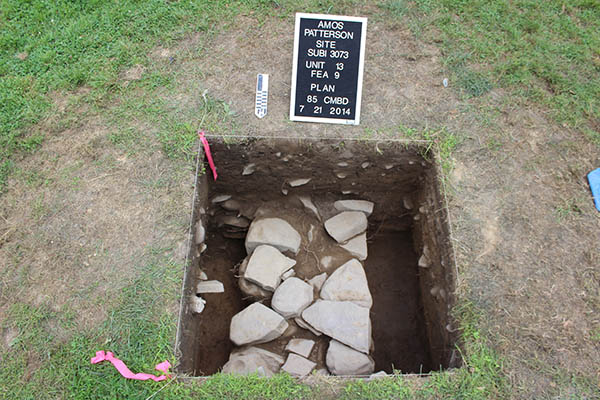The 2014 CAP program was at the historic Amos Patterson house site in the Town of Union, Broome County, New York. Excavations took place in the yard area surrounding the standing Federal period Amos Patterson house. The house was built c. 1800 by the Patterson family and is one of the oldest standing structures in Broome County. It was part of a larger farmstead during the 19th and 20th centuries, but most of the farm acreage has been swallowed up by urban development. Our research focused on understanding daily life and activities at the home site and how these related to the social circumstances of the families who lived here. During the course of our research, we also identified prehistoric Native American artifacts and further explored areas where these were found.
Amos Patterson came to Broome County from Massachusetts as one of a group of land speculators involved in the Boston Purchase, which included land in the Town of Union. He built the elaborate federal-style house less than a decade after the family had settled in Union; probate records show he was a wealthy man. His estate was worth $10,000.00 at his death in 1817 and included the farm and saw mill operations. This was a considerable sum in the early 19th century. Most of the Patterson holdings in Union passed to his son, Chester, who sold the property in 1839 to the Holberts. Their residence was brief and, by 1845, the farm had been sold to the Sayer family. It is during this period that the home was operated as a temperance inn that offered the traditional society and entertainment of the tavern without the alcohol. Joseph Sayer was a devotee of the Washingtonian Society, a temperance society oriented toward reform of the individual alcoholic through personal stories. The house became known as Washingtonian Hall. The Sayre family farm value was well above the average for Broome County in 1850, but their fortunes declined in the late 19th and early 20th centuries. By the time that they sold the property to Thomas MacClary in 1924, the house was in disrepair. The foundation had to be replaced and afforded the MacClary's the opportunity to move it back from the Susquehanna River and trolley tracks that ran close to the front of the house.
The house move presented archaeologists with some challenges. One of our first goals was to establish the former location of the house so that we had a better idea of the likely locations of yard features, trash middens, and other historic features. We did locate some rubble associated with the former house foundation and a relatively intact section of foundation marking the previous location of the kitchen wing. Excavations in the rear yard located a deep midden that was probably redeposited when the new cellar area was dug out. Stratigraphy in this midden was inverted; that is, earlier artifacts were closer to the surface than later artifacts, suggesting that it had been redeposited in reverse order. This midden and sheet midden from other yard areas contained ceramics, glass, nails, and other artifacts from the 19th through early 20th centuries.
The prehistoric Native American occupation at the site, close to the Susquehanna River, yielded flakes from making stone tools and cord-impressed pottery. The cord-impressed pottery indicates that the site has at least one occupation dating to the Late Woodland period (c. AD 900-1300). CAP excavations also found several post molds that may relate to a Native American structure.
The Amos Patterson site has already yielded new insight into the prehistory and early history of this region. Analysis of the prehistoric and historic material is on-going and this important site has more stories to tell us.
